The Green Beans & Almonds Holiday Classic Made Low FODMAP
There is hardly a meal that isn’t made better with a side of green vegetables. At the holidays it is a must. With all of the rich food – turkey, stuffing, gravy, potatoes and what have you – we need an accent of a crisp green, like these Pan-Roasted Green Beans & Almonds.
The oven is often jam-packed with other menu items, so a stovetop veggie option is a good addition. This is a low FODMAP take on the classic green beans and almonds dish that seems to make appearances around this time of year.
Read more about Green Beans in our Explore and Ingredient article. This easy-to-prepare low FODMAP veggie is in constant rotation in our diets.
PS: We like to take advantage of the already trimmed, slender, bagged green beans that we can find in our supermarkets. They come prepped and ready to go.
We typically buy our vegetables loose by the pound, but these are usually quite good. Just make sure to get a fresh package; you can see through the plastic to see if the green beans are nice and fresh.
They should be crisp and stiff, never flabby, have good green color with no discoloration – which goes for any green beans you are buying!
BTW almonds are low FODMAP in small amounts and our serving size recommendation takes the Monash University lab tested amounts into consideration.
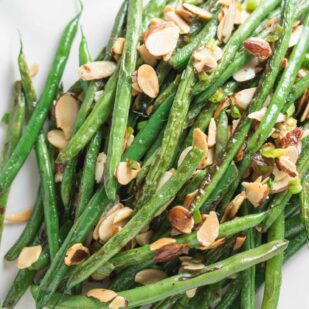
Pan-Roasted Green Beans & Almonds
This recipe for Pan-Roasted Green Beans & Almonds is low FODMAP and vegan. Great for the holiday table or anytime you want something a little special.
Ingredients:
- Kosher salt
- 12 ounces (340 g) fresh, trimmed, slender green beans
- 5 tablespoons (75 ml) extra-virgin olive oil, divided
- 1/3 cup (29 g) sliced almonds, natural or blanched
- 3 tablespoons finely chopped scallions, green parts only
- Freshly ground black pepper
Preparation:
-
Bring a large pot of salted water to a boil. Drop in the beans and cook just until they are very crisp/tender - you will be cooking further in a sauté pan, so do not overcook. This will take less than 3 minutes. Drain well in colander and then let very cold water flow over them, tossing them in the colander once or twice to release heat. Keep the cold water flowing until the beans are cool. Pat them very dry with paper towels.
-
Heat 1 tablespoon olive oil in large sauté pan over medium heat until hot. Add almonds and toss around until very light golden brown, add scallions, toss to coat and soften, then remove nut mixture and set aside.
-
Add remaining olive oil to pan over medium-high heat. Add the dried green beans and cook for a minute or so until they begin to blister, tossing occasionally. Toss in nut mixture to incorporate. Season to taste with salt and pepper and serve immediately.
Notes:
Tips
- After draining the beans in the colander you could shock them in a big bowl of ice water, which will halt their further cooking immediately. While this is the classic technique, which works very well, I find that many people do not always have a large amount of ice around, which is why we provided an alternative technique.
Nutrition
All nutritional information is based on third-party calculations and should be considered estimates. Actual nutritional content will vary with brands used, measuring methods, portion sizes and more. For a more detailed explanation, please read our article Understanding The Nutrition Panel Within Our Recipes.
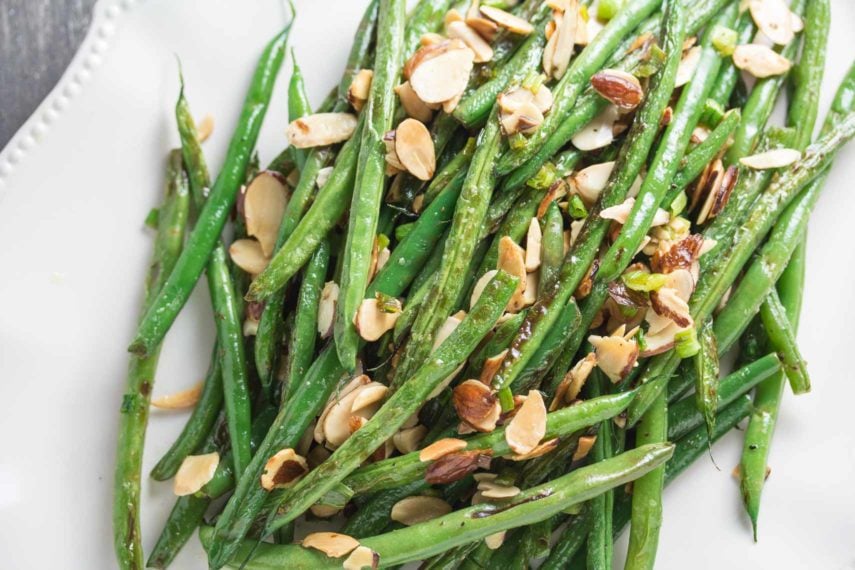
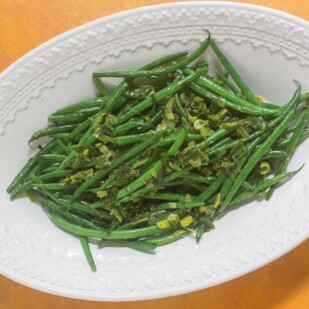
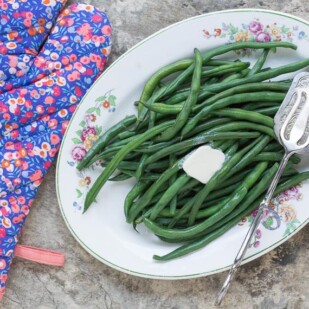





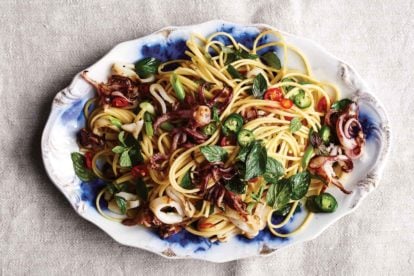
Question-20 almonds are high fodmap and that filled only half the 1/3 cup. How is this low fodmap? Do we not eat the almonds?
Hi Kim, what great timing for this question! I am actually working on an article right now on serving sizes and portions. The low FODMAP diet is ALL about portions and serving sizes. This is why, perhaps, you have seen almonds on both low FODMAP lists as well as high FODMAP lists. As you probably know, they have a big fat Red Light next to them on the Monash app, but that is because the “serving size” was very arbitrarily set at 20 nuts. 10 nuts, at 12 g, is considered Green Light/low FODMAP. If you follow the serving size recommendations for our recipes, you will be within a low FODMAP serving size. The caveat is that these serving sizes are based on what Monash has determined to be the amount of a food, in this case, almonds, that “should be tolerated by most individuals with IBS”. None of this is etched in stone. Hopefully you are embarking on this diet with a Monash trained RD and conducting a structured Challenge Phase. During that phase you might discover that you can tolerate twice this amount of almonds, or perhaps half this amount. Regardless of what the app says, or our recipes says, what YOU discover about your digestive relationship to almonds is what is ultimately the most important thing. Use the app and recipe serving size recommendations as the place to start.